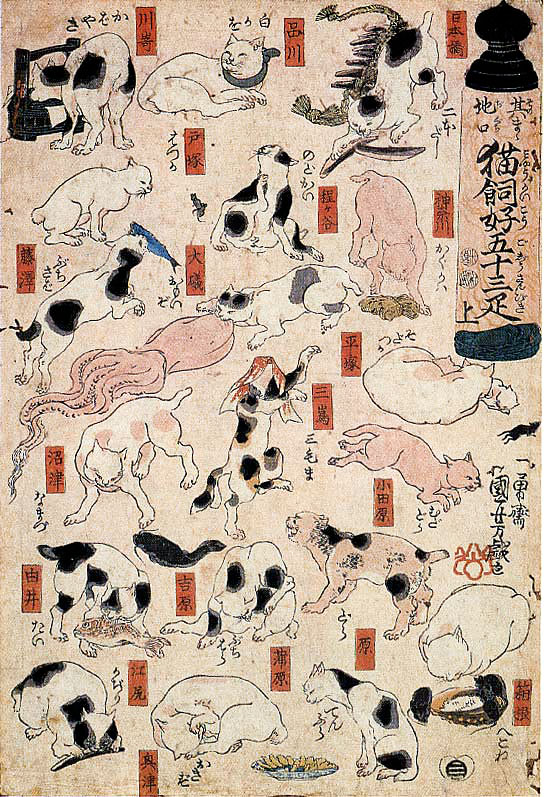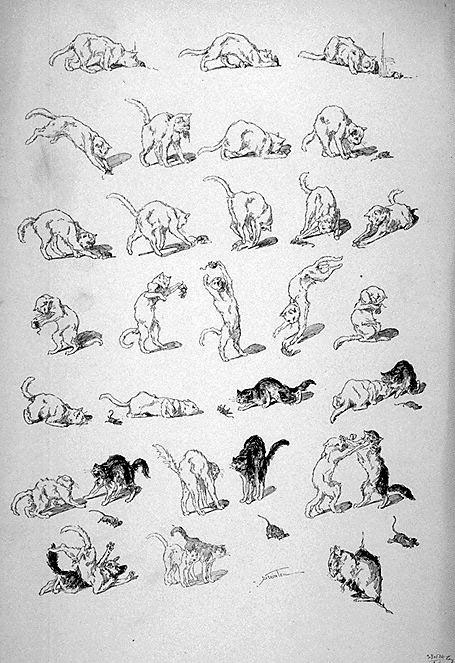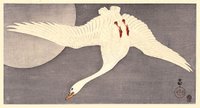04 November 2006
meadowsweet
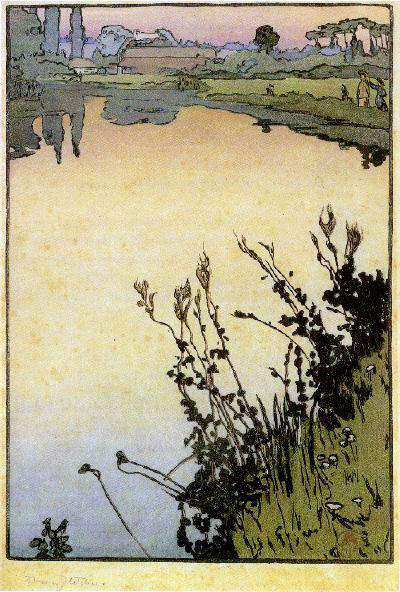 frank morley-fletcher was born in england but moved to california and created some of the most important woodblock prints of early california. he was one of bjo nordfeldt's most important teachers of the woodblock process.
frank morley-fletcher was born in england but moved to california and created some of the most important woodblock prints of early california. he was one of bjo nordfeldt's most important teachers of the woodblock process.morley-fletcher's 1916 instructional manual, 'woodblock printing by the japanese method,' is entirely online here.
 the whole woodblock.com is jam-packed with woodblock printing information. find also another manual on this by hiroshi yoshida.
the whole woodblock.com is jam-packed with woodblock printing information. find also another manual on this by hiroshi yoshida.Labels: frank morley fletcher, hiroshi yoshida
03 November 2006
serendipity
 i'd talked about my trip to japan, france, and new york (with rutgers thrown in), but i didn't mention that it was in october of 1989--a date which may hold meaning for other san francisco bay area residents too: the loma prieta earthquake. remember? middle of a baseball game?
i'd talked about my trip to japan, france, and new york (with rutgers thrown in), but i didn't mention that it was in october of 1989--a date which may hold meaning for other san francisco bay area residents too: the loma prieta earthquake. remember? middle of a baseball game?  the "big one"?
the "big one"?i also didn't mention the quandry that put me in, because there i sat in my nyc hotel room, watching bits of san francisco burning on the tv,
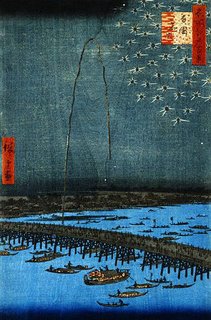 but there was still one stop in man- hattan i really wanted to make.... and i did end up making it.
but there was still one stop in man- hattan i really wanted to make.... and i did end up making it.i went to the hirschl adler gallery to see their arts and crafts show, since immortalized in their book, 'from architecture to object.' and there i saw for the first time the work of b.j.o. nordfeldt.
 it was a print called 'the long wave' which took my breath away, still does. i can't find it online, and will try scanning it in, but there are others i've found since that do as well.
it was a print called 'the long wave' which took my breath away, still does. i can't find it online, and will try scanning it in, but there are others i've found since that do as well. in particular, 'the branch,' above.
in particular, 'the branch,' above. nordfeldt was primarily a painter, but i know him mostly by his very few woodblock prints. most of these were done in 1906, the year he saw frank lloyd wright's collection of hiroshige prints at the chicago museum of art. while there's no knowing for sure which images inspired which, i've suggested some, aided a bit by the book 'japonisme comes to america,' by julia meech and gabriel weisberg.
nordfeldt was primarily a painter, but i know him mostly by his very few woodblock prints. most of these were done in 1906, the year he saw frank lloyd wright's collection of hiroshige prints at the chicago museum of art. while there's no knowing for sure which images inspired which, i've suggested some, aided a bit by the book 'japonisme comes to america,' by julia meech and gabriel weisberg.Labels: bjo nordfeldt, hiroshige ando
02 November 2006
purely Japanese character
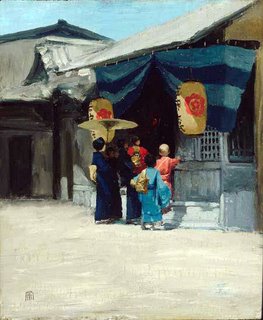 mortimer menpes spent the final years of his life as a farmer, growing fruit and carnations.1 but before he retired to the country, his life was the stuff of dreams (though, in truth, perhaps the farm was a dream as well).
mortimer menpes spent the final years of his life as a farmer, growing fruit and carnations.1 but before he retired to the country, his life was the stuff of dreams (though, in truth, perhaps the farm was a dream as well).after moving to england from australia, menpes was swept into the japonisme craze. he became whistler's apprentice and helper. but unlike whistler, menpes actually went to japan, and he went more than once.
In his paintings of Japanese daily life, Menpes explores the subtleties of Japanese art, emulating the balance and perfection which he saw all around him and describes in some detail in his notes accompanying his illustrations in Japan A Record in Colour. Menpes admired the Japanese painters who would ponder for hours and sometimes weeks over the placing of every last object in their paintings. The proper placing of objects is not only an exact science, but also it forms almost a religion with the Japanese. When you just arrive in Japan you are at once impressed with the perfect placing of everything about you."2
 The dining room at 25 Cadogan Gardens, Mr. Mortimer Menpes' House
The dining room at 25 Cadogan Gardens, Mr. Mortimer Menpes' House The cabinets of purely Japanese character in the dining-room ... are charming in their frank simplicity, and greatly to be preferred to the over-elaborated and decorated cabinets with their carved ivory and pearl inlays which have been made in recent years by the Japanese for the European market.3
 one of menpes' trips to japan was deliberately to work with craftspeople to manufacture things for his home. menpes felt much western work was shoddy and was seeking the fine hand craftsmanship of japan.4 unfortunately, whistler (not uncharacteristicly) blew into a rage and fired menpes for having stolen japonisme ideas from him!
one of menpes' trips to japan was deliberately to work with craftspeople to manufacture things for his home. menpes felt much western work was shoddy and was seeking the fine hand craftsmanship of japan.4 unfortunately, whistler (not uncharacteristicly) blew into a rage and fired menpes for having stolen japonisme ideas from him!Labels: mortimer menpes
01 November 2006
she stoops to conquer?

 david wondered at the artists of the day portraying dancers, loie fuller, josephine baker, in so much artwork. so what else is new? these are the superstars, the sex-goddesses. it was always thus. and here we are again with sarah bernhardt. and courtesans, the more combs and layers the better. whom other do we have without tv and rock videos?
david wondered at the artists of the day portraying dancers, loie fuller, josephine baker, in so much artwork. so what else is new? these are the superstars, the sex-goddesses. it was always thus. and here we are again with sarah bernhardt. and courtesans, the more combs and layers the better. whom other do we have without tv and rock videos?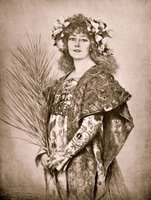
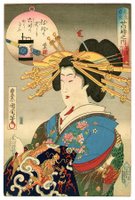 some fascinating differences that i noticed, though. it was difficult to find any image of sarah bernhardt without her head held high. pride? arrogance? i think we'd probably be surprised to find her bowed.
some fascinating differences that i noticed, though. it was difficult to find any image of sarah bernhardt without her head held high. pride? arrogance? i think we'd probably be surprised to find her bowed.
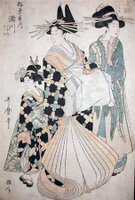 but we find the geisha, the bijin, the courtesan-poets almost no other way.
but we find the geisha, the bijin, the courtesan-poets almost no other way.beautiful woman in the west stands tall and smiles. beautiful woman in the east does neither. does this legacy hold? i doubt it. but this is what the artists recorded for several centuries in japan. it's hard for me to see it except through western eyes. what does it mean?
Labels: Chikanobu Toyohara, comment, fashion, Kunichika Toyohara, paul berthon, Utamaro Kitagawa, women
seeing the moonlight
 seeing the moonlight
seeing the moonlightspilling down
through these trees,
my heart fills to the brim
with autumn.
ono no komachi
see the charming website 'crackle mountain' in which japanese and chinese folk tales are illustrated with images choices that span the ages.
 (poem from 'the ink dark moon,' translations by jane hirshfield and mariko aritani. top left artwork by hiroshige. top right artwork by walter j phillips.)
(poem from 'the ink dark moon,' translations by jane hirshfield and mariko aritani. top left artwork by hiroshige. top right artwork by walter j phillips.)Labels: hiroshige ando, ono no komachi, walter j phillips
31 October 2006
too many legs
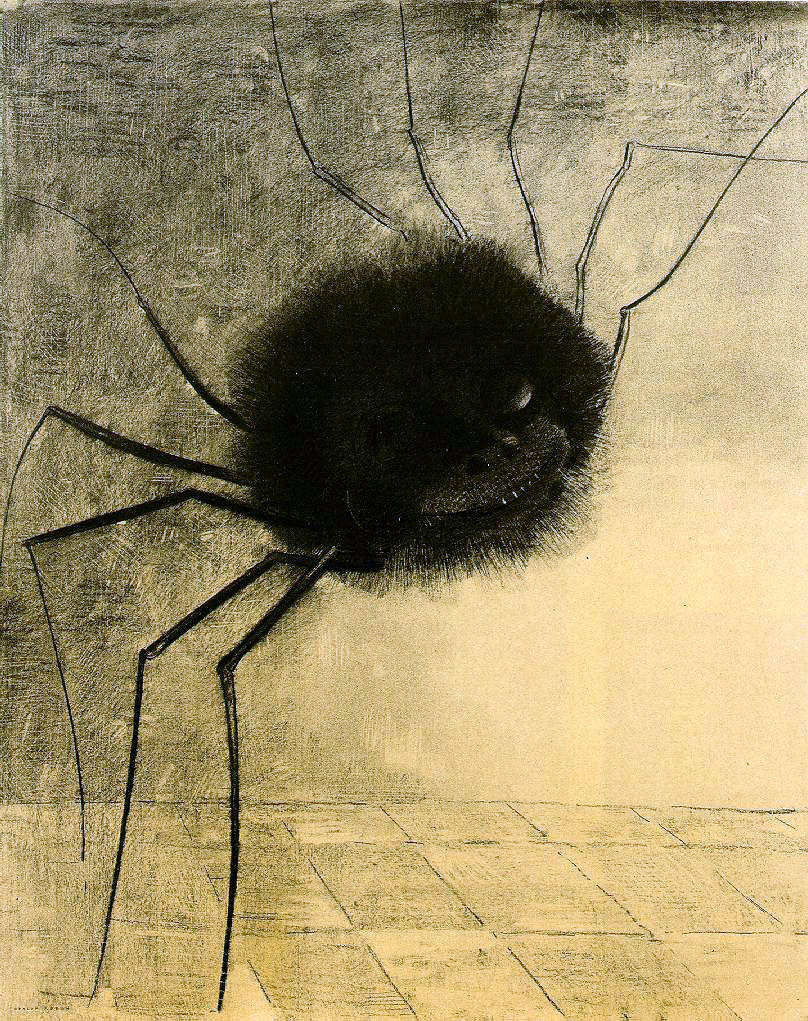 the earth was filled with demons in the 12th century; just ask anyone who has been there. demons who shape-shift. demons who can take just the form that will most beguile you. demons who will mis-deliver your email (no--wait. different spelling)
the earth was filled with demons in the 12th century; just ask anyone who has been there. demons who shape-shift. demons who can take just the form that will most beguile you. demons who will mis-deliver your email (no--wait. different spelling) the brave warrior was awoken one night by the most beautiful of all women, but he did not notice she was hanging by a silken thread from the ceiling! she began to work her magic, to tantalize, entrance and entice him. he nearly lost his manly spirit!
the brave warrior was awoken one night by the most beautiful of all women, but he did not notice she was hanging by a silken thread from the ceiling! she began to work her magic, to tantalize, entrance and entice him. he nearly lost his manly spirit!at the last moment his faithful manservant noticed that, on the wall behind her was
THE SHADOW NOT OF A WOMAN, BUT OF A SPIDER!!
he smote (smited?) the spider and everyone lived happily ever after. but when the little spider in your corner calls out to you tonight, ignore it, pretend you don't hear, turn your face to the wall and
turn up your ipod.
and if you wake with someone that you don't remember, be careful. they just might have six too many legs.
happy halloween!
('smiling spider' by odilon redon; 'raiko and the spider' by yoshitoshi tsukioka)
Labels: odilon redon, yoshitoshi Taiso
fantastic impressions

i struck out for a new and method of work which was founded on japanese art quite original in the main... fantastic impressions treated in the finest possible outline with patches of 'black blot.'
AUBREY BEARDSLEY
 taking freely all that the japanese art could give him, that release from the bondage of what we call real things, beardsley made the world over again in his head, as if it existed only when it was thus re-made... in black line on a white surface,
taking freely all that the japanese art could give him, that release from the bondage of what we call real things, beardsley made the world over again in his head, as if it existed only when it was thus re-made... in black line on a white surface,
in white line on black surface.
ARTHUR SYMONS, fortnightly review, may 1, 1898
(quotes from 'beardsley, japonisme, and the perversion of the victorian ideal'; zatlin; columbia university press 1997)
upper print from a hokusai manga
AUBREY BEARDSLEY
 taking freely all that the japanese art could give him, that release from the bondage of what we call real things, beardsley made the world over again in his head, as if it existed only when it was thus re-made... in black line on a white surface,
taking freely all that the japanese art could give him, that release from the bondage of what we call real things, beardsley made the world over again in his head, as if it existed only when it was thus re-made... in black line on a white surface,in white line on black surface.
ARTHUR SYMONS, fortnightly review, may 1, 1898
(quotes from 'beardsley, japonisme, and the perversion of the victorian ideal'; zatlin; columbia university press 1997)
upper print from a hokusai manga
Labels: aubrey beardsley, hokusai
30 October 2006
29 October 2006
the butterfly dance
 the butterfly dance served to inspire a dancer who was to become the toast of all of paris.
the butterfly dance served to inspire a dancer who was to become the toast of all of paris.Around the turn-of-the-century the figure of the dancer, and particularly that of Loïe Fuller, can be found at the heart of an aesthetic revolution in Paris. Fuller appears in writings on this historical period as the figure who “embodied” the changing perception of human physicality, in particular its function regarding the production of meaning. Fuller's dancing is an exemplary model of transformation through flux and rhythmic continuity.
Following is a description of Fuller by her contemporary, Isadora Duncan, who travelled with Fuller to Berlin prior to her own successful tours to Europe: "Before our very eyes she turned to many-coloured shining orchids, to a wavering, flowing sea-flower, and at length to a spiral-like lily, all the magic of Merlin, the sorcery of light, colour, flowing form... She transformed herself into a thousand colourful images before the eyes of her audience. Unbelievable. Not to be repeated or described."
 This was a dance of transformation through motion; flowing, spiralling, wavering, turning movements that fired audience's imaginations and inspired multiple readings of the morphing shapes she created. Marked by instability as a signifier and a quality of constant flux, this art was “not to be repeated or described”, a dance of continual invention that bypassed poses and postures, emulating the ephemeral “flow of life”.
This was a dance of transformation through motion; flowing, spiralling, wavering, turning movements that fired audience's imaginations and inspired multiple readings of the morphing shapes she created. Marked by instability as a signifier and a quality of constant flux, this art was “not to be repeated or described”, a dance of continual invention that bypassed poses and postures, emulating the ephemeral “flow of life”.Stephane Mallarme, the leading poet of the Symbolist movement, dubbed her "La Loie" and described her dancing as "the dizzyness of soul made visible by an artifice."
video of "skirt dancing"
more photos of la loie and of sada yacco, a dancer from japan who came to study and dance with fuller. (go all the way to the end on the right, then click on the photo)
 and only a few of the artistic renditions of the artist...
and only a few of the artistic renditions of the artist...Labels: dance, loie fuller
shall we dance
no
 frankly i'm not fully satisfied with my answer to lauren, and i've realized i needed to know more about the wider japanese arts culture. i've barely scratched the surface of course, but i'll report some things i've found:
frankly i'm not fully satisfied with my answer to lauren, and i've realized i needed to know more about the wider japanese arts culture. i've barely scratched the surface of course, but i'll report some things i've found: i found no couples dancing at all. until the westerners came, there were plenty of spring painting prints, explicitly spring painting and perfectly matter-of-fact, the neighbor, maid, grandpa or child popping in to say this or that.... but no face-to-face dancing.
i found no couples dancing at all. until the westerners came, there were plenty of spring painting prints, explicitly spring painting and perfectly matter-of-fact, the neighbor, maid, grandpa or child popping in to say this or that.... but no face-to-face dancing. and frightfully little group dancing. there are some images of a group of women doing a spring festival dance, but so few that i've been unable to find any online thus far.
and frightfully little group dancing. there are some images of a group of women doing a spring festival dance, but so few that i've been unable to find any online thus far. but there are single or paired dancers, men, or women.... and sometimes i can't tell which is which! they impersonate each other, and being a westerner i have not yet educated my eyes to tell the difference. (though noh and kabuki were all men when the westerners arrived, they were mixed, centuries ago when they began. it seemed however that some women discovered courtesanry more profitable than theater, and eventually all women were banned.) this is the butterfly dance; we'll be seeing that again soon.
but there are single or paired dancers, men, or women.... and sometimes i can't tell which is which! they impersonate each other, and being a westerner i have not yet educated my eyes to tell the difference. (though noh and kabuki were all men when the westerners arrived, they were mixed, centuries ago when they began. it seemed however that some women discovered courtesanry more profitable than theater, and eventually all women were banned.) this is the butterfly dance; we'll be seeing that again soon. yes, there are huge theaters with kabuki and scores of people having dinner while they watch, but these three images really represent what i can find of dance--at least as we define it in the west. there are dances with spiritual connotations, but those are not generally for an audience.
yes, there are huge theaters with kabuki and scores of people having dinner while they watch, but these three images really represent what i can find of dance--at least as we define it in the west. there are dances with spiritual connotations, but those are not generally for an audience.of course, ukiyo-e is the art of the floating world. it's the art of the theater and the geisha and the courtesans and the butterfly dancers. some of the rules, restrictions, that came about when the west came in, sadly, slowed down production of the "green house" images.
(seed sowing dance)
Labels: dance, eisen tomioka, Shuntei Miyagawa, Tsukioka YOSHITOSHI



